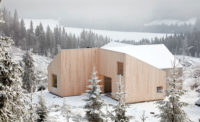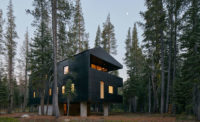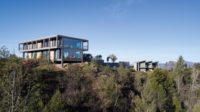As with culinary innovations like Korean beef tacos or the Cronut, architecture often benefits from cross-cultural influences. In the case of Casper Mork-Ulnes, his Norwegian origins combined with a California upbringing—thanks to a diplomat father—have turned out to be a happy fusion. “[We] Scandinavians are very stoic and practical,” he says. “But from living in California, this emphasis on functionality is cross-pollinated with a sense of optimism and playfulness. My architecture isn’t monastic in its simplicity.”
This freewheeling West Coast spirit comes across in the architect’s primarily residential practice. Mork-Ulnes designed a getaway in rural northern California that is essentially three periscopes pointed at different views; he reimagined a barn with an expressive butterfly roof and enough reclaimed barn siding for several hipster cafés; and he created a curving concrete dining pavilion with plants growing through holes in the floor and nicknamed it “the Amoeba.” It’s easy to imagine these buildings—along with the rest of the architect’s body of work—beginning as simple but evocative sketches. The 42-year-old architect originally attended San Francisco’s CCA (California College of the Arts) in the mid-1990s with the intention of becoming an artist or graphic designer. But his imagination was captured by some Aldo Rossi drawings, and a studio class with California modernist Jim Jennings led him to pursue his studies in architecture instead.
After completing a master’s degree in advanced architectural design at Columbia, he was among a group of architects who were drawn to the possibilities of prefabricated buildings. He cofounded a company called Modern Cabana, which produced more than 100 wood-clad studios, shipped as panels so customers could assemble the units themselves. The experience, along with his native Janteloven (a Norwegian term for modesty and restraint), has given Mork-Ulnes an affinity for limited budgets and particularly for economical claddings, including skateboard-ramp material and bonderized sheet metal. He has also used a combination of tar and linseed oil as an exterior wood finish, which is common in Scandinavia, but rare in the U.S.
In 2011, he moved his family to Oslo, a change of address precipitated by his wife, an interior designer with the firm and a fifth-generation San Franciscan, who wanted the experience of living in Europe, both for herself and their two children. He still maintains an active practice in San Francisco and hasn’t left his sunny California optimism behind. He is close to completing an 800-square-foot ski cabin in the wilds of Norway that emphasizes indoor-outdoor living. Instead of having a single pitched roof, the cabin has been deconstructed into a group of shed-like forms so that snow will collect and slide away from its two courtyards. “The design is
100 percent driven by the climate,” says Mork-Ulnes. Back in California, he’s also working on a master plan for a 30-acre development of modest ski-in cabins—a modern take on the European tradition of cross-country skiing to a warming hut. “It’s about cutting away the fat and paring away to the essentials,” says Mork-Ulnes. “Sometimes luxury is about simplicity.”
Mork Ulnes Architects
FOUNDED: 2005/2006
DESIGN STAFF: 8
PRINCIPAL: Casper Mork-Ulnes
EDUCATION: Columbia University, M.S. Advanced Architectural Design, 2002; California College of Arts, B.Arch., 1997
WORK HISTORY: Modern Cabana 2005–11 (founding partner); Pfau Architecture, 1995–2005
KEY COMPLETED PROJECTS: Mules Ear Dr. Residence, Tahoe, CA, 2015; Akersveien Residence, Oslo, 2014; Meier Rd. Pavilion, Sonoma, CA, 2014; Meier Rd. Studio, Sonoma, CA, 2012; Trinity Rd. Residence, Sonoma, CA, 2011; Moose Rd. Residence, 2011; 20th St. Residence, San Francisco, 2011
Key Current PROJECTS: Mylla Cabin, Nordmarka, Norway, 2015; Svalestien, Ås, Norway, 2015; Adobe Way, Sonoma, CA, 2016; Trinity Rd. Guesthouse, 2016; California College of Arts, 2016


























Post a comment to this article
Report Abusive Comment